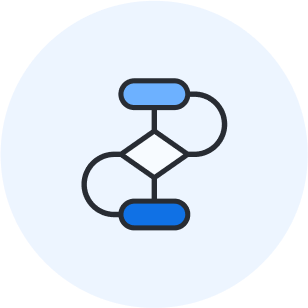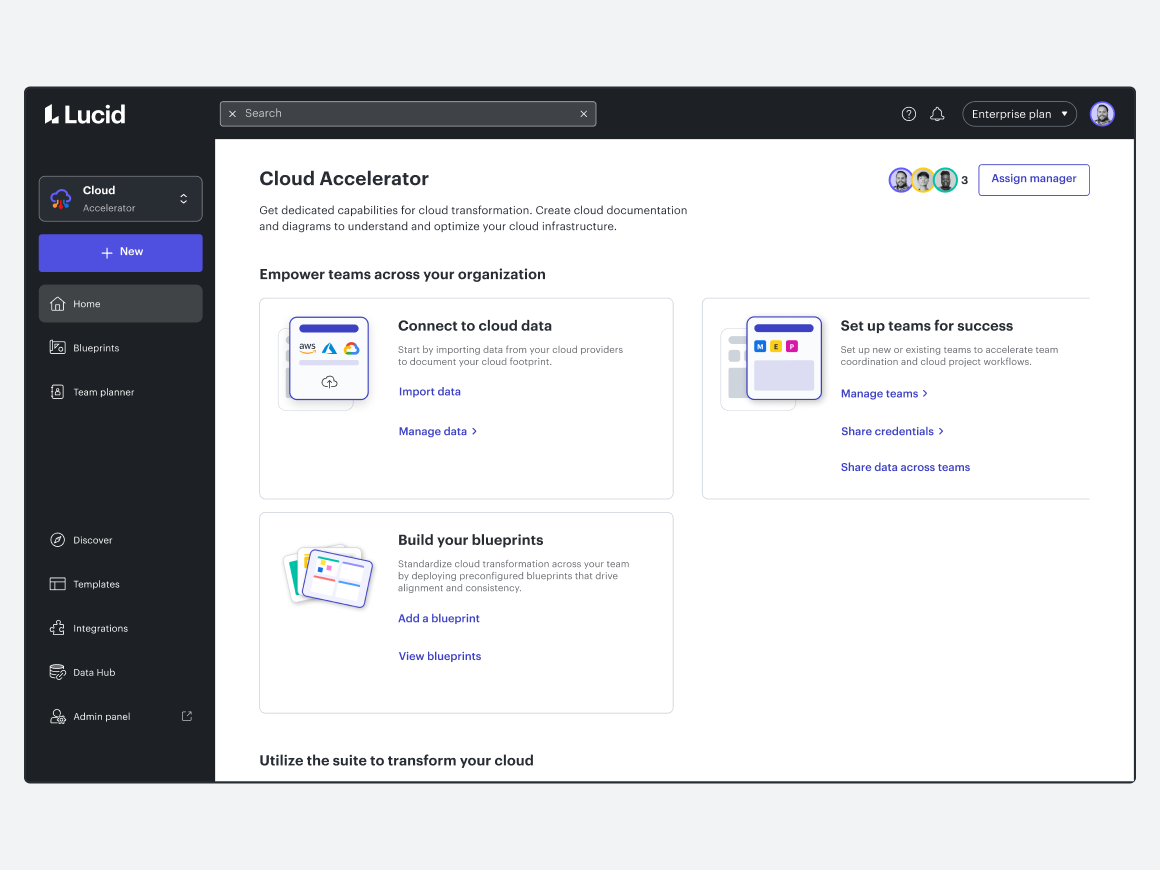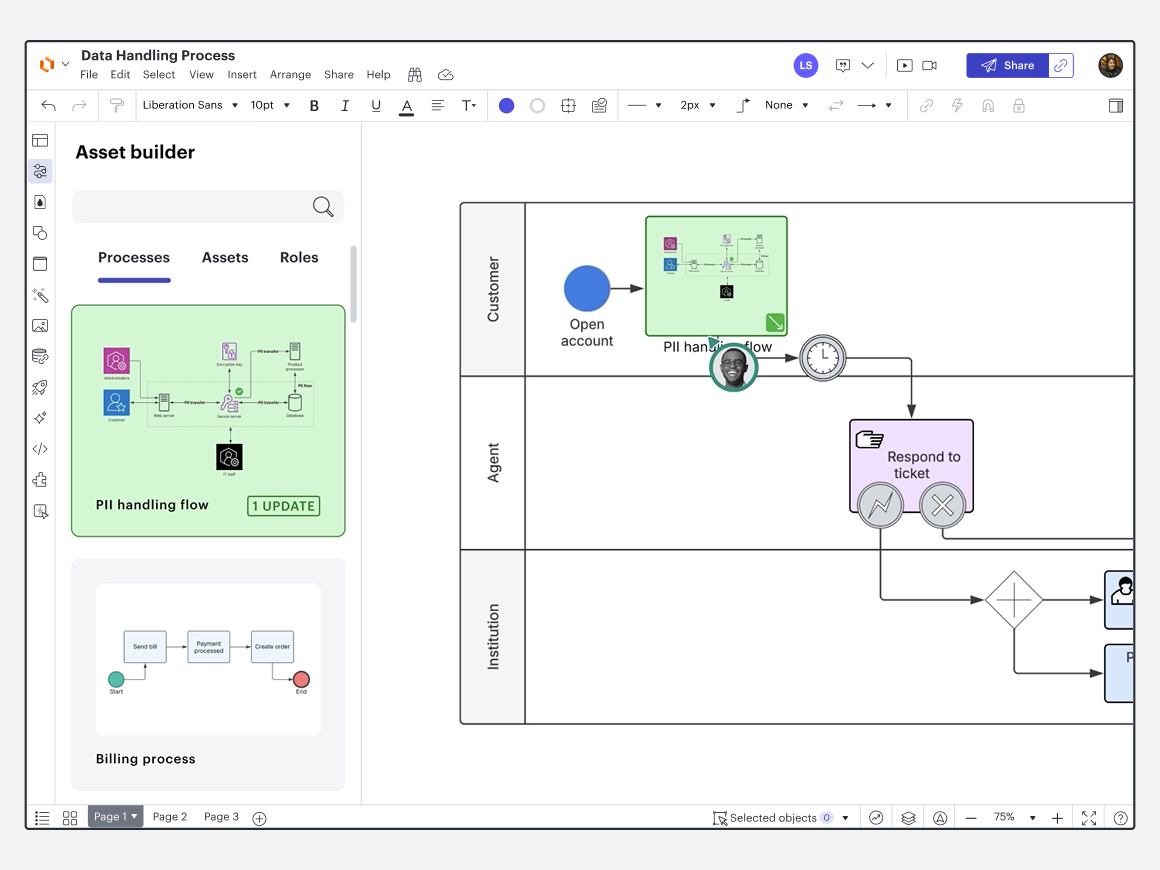
What is work acceleration? Defining the next era of work
Nathan Rawlins
Reading time: about 11 min
There’s an old adage, “The pace of change has never been this fast, yet it will never be this slow again.”
This expression was around before the rise of generative AI, when LLMs hadn’t yet become an everyday workplace tool. When the pandemic had not yet upended the workplace, and remote work was a niche perk, not a default working model.
This saying has always rung true, of course. But it carries a different weight and urgency today.
The rate of change rose a dramatic 183% in the past few years (2019 to 2023), and 72% of C-suites anticipate more change throughout 2025 compared to 2024.
We need to ask ourselves: Are we equipped to adapt at the same rate?
As our team at Lucid reflected on this question, it became clear that businesses today need new strategies, workflows, and technology to navigate an era of work that’s marked by relentless change. So we got serious about looking at exactly what challenges slow teams down the most and what solutions could propel them forward faster.
From this analysis, we’ve uncovered the necessity for a new core capability: work acceleration.
What is work acceleration?
Work acceleration is the process of bringing teams together to transform the business through efficient collaboration, continuous alignment, and increased adaptability.
A work acceleration platform, then, is where teams come together to problem-solve, brainstorm, plan, you name it. In other words, it’s where the work itself gets done. And it gets done quickly, with purpose-built capabilities to facilitate alignment, automate workflows, and enable decision-making.
At the very core of work acceleration is visual collaboration. I know that many organizations have already experienced the power of visual collaboration—that is, collaborative activities such as ideating, planning, and diagramming that take place on a visual, infinite canvas—in fueling innovation and productivity.
Work acceleration can be considered the next evolution of visual collaboration. It goes a step further by applying the powerful capabilities of visual collaboration to large-scale transformation initiatives such as Agile transformation, cloud transformation, process transformation, or new product development.
Lucid, for example, has evolved from a visual collaboration platform to a work acceleration platform by deepening its capabilities with the acquisition of airfocus and three powerful accelerators: purpose-built solutions for scaling and standardizing key workstreams, and, ultimately, accelerating business transformation.
Why is a work acceleration platform necessary?
A work acceleration platform helps teams work faster by directly addressing the hurdles that slow down progress. We recently surveyed knowledge workers worldwide to uncover the most pressing roadblocks.
I’ll break each of those challenges down here:
-
Scattered information: More than a third (38%) of respondents don’t know where to go to get all project resources. And 48% spend one to two hours a day just searching for information. That’s five to ten hours per week—essentially a full work day!
-
Ineffective collaboration: 42% of workers say frequent meetings and interruptions make it difficult to work efficiently. What’s worse is that these meetings not only interrupt work, but they aren’t often effective: Over 60% of people frequently leave meetings without clear next steps.
-
Misalignment: The percentage of respondents citing team misalignment as a project workflow challenge rose from 32% in 2024 to 44% in 2025, which just so happens to coincide with the increasing pace of change I talked about earlier.
-
Lack of visibility: 35% say projects always or often miss deadlines or fall short of company objectives. To help projects meet deadlines, workers say they’d need more visibility into these five areas: project development timelines and product roadmaps, proven strategies from other teams, project goals, operational processes, and cross-departmental dependencies.
-
Prolonged decision-making: Another major roadblock to working efficiently is slow or long decision-making processes, cited by 40% of respondents. The time it takes for teams to build consensus has also increased compared to just six months ago.
-
Inconsistency and repeated work: Nearly a third of knowledge workers say they’re recreating processes multiple times a week. What would help? Respondents list easily accessible documentation, access to real-time data, and templates for frequent projects. In fact, one in five knowledge workers estimates that access to standardized process documentation would save them three or more hours a day.
No matter what your business goals are, I can’t overstate the importance of addressing these challenges now, before it’s too late and too hard to catch up to those that have proactively managed them.
Work acceleration is specifically designed to address these challenges, helping you not only respond to change and innovate but also save the business time and money with an overall more efficient operating model.

Work acceleration examples
See how six companies have improved operational efficiency by using Lucid’s work acceleration platform.
Go nowHow does a work acceleration platform, well, work?
You can think of a work acceleration platform as a system of action. Unlike the more commonly known system of record, a system of action isn’t just a passive database. Sure, it maintains and connects to valuable repositories, but a system of action helps you actually leverage this information to execute tasks efficiently.
In the case of work acceleration, the platform helps you take action to drive change by:
- Acting as a hub to coordinate work, communicate updates, and align on progress
- Offering robust templates and blueprints for common workflows
- Providing flexible collaboration tools to support ideation, facilitation, and prioritization
- Visualizing roadblocks, timelines, dependencies, and scenarios to plan effectively
- Equipping teams with AI and automation to accelerate diagramming, brainstorming, synthesizing, and more
- Integrating with popular applications to streamline work
- Centralizing key documentation with built-in capabilities to easily update documents
Here’s one of my favorite examples: Lucid’s work acceleration platform connects to Jira and Azure DevOps to present that otherwise static information in a dynamic, visual timeline. In Lucid, teams can map dependencies, plan scenarios, and adjust dates or other task details as needed. Any changes made in Lucid, the system of action, are automatically updated and reflected in Jira or ADO, the system of record.
Lucid isn’t intended to replace these systems; it complements the valuable structure that tools like Jira and ADO offer with a separate yet connected space for the loose, often messy work that’s a necessary part of collaborative planning.
A scrum team adjusting tasks per capacity over the course of three sprints in a Dynamic Table using the scenario planning capability of Lucid's Agile Accelerator
Defining characteristics of work acceleration
What capabilities truly help accelerate work? We’ve identified a few defining characteristics that are non-negotiable for work acceleration platforms.
Powered by visual collaboration
Because visual collaboration is at the core of work acceleration, all the key characteristics of visual collaboration apply here as well. Those include:
- Facilitation of real-time and asynchronous collaboration, leading to more effective (and fewer) meetings
- Clarity around complex ideas, plans, systems, data, and more, leading to increased visibility for teams and stakeholders
- Robust feedback and synthesis capabilities, leading to better alignment and quicker decision-making

Learn more about the key characteristics of visual collaboration.
Learn moreIntelligent
Intelligence and automation have long been key to visual collaboration. For example, through visual collaboration, you can add conditional formatting to a diagram to quickly interpret data. Or, you could use AI to summarize the themes from a large brainstorm to easily identify trends.
Work acceleration extends these intelligent capabilities to scaling key initiatives. For example, with Lucid’s Agility Accelerator, you can collect qualitative insights around team confidence, sentiment, and risk data and share insights across the entire organization in a comprehensive dashboard. With this data all in one place, you can easily spot the most pressing problem areas to address.

Interconnected
When information is scattered across tools, teams spend far too much time searching for information and not enough time on valuable work. To reduce the amount of context and tool switching, a work acceleration platform should integrate with the other main tools in your tech stack, including task management software, meeting platforms, documentation tools, interactive whiteboards, cloud providers, and more.
With Lucid’s Cloud Accelerator, for example, teams can visualize their current cloud infrastructure by automatically importing data from AWS, Azure, or Google Cloud. From here, teams can add shapes and unmapped resources to better understand their current state. With this integration, teams can spend more time optimizing, planning, and troubleshooting their cloud environments.

Standardized
One of the most powerful things about visual collaboration is that it's flexible and fluid—the perfect space for riffing on ideas and plans without getting locked into anything. When we think about transformation initiatives, though, standardization is vital to scaling what works and moving faster. When common workflows are standardized, teams don’t have to spend time figuring out how to work—they can just do the work.
That’s why a work acceleration platform allows you to seamlessly transition your freeform work into structured, reusable components when you’re ready to scale.
For instance, with the Agility Accelerator in Lucid, you can create and distribute blueprints, a collection of templates for common activities such as sprint planning or retrospectives that give teams a starting point to increase consistency without sacrificing flexibility.
Or, you can use Lucid’s Process Accelerator to create and maintain a library of assets commonly used throughout multiple process documents. When you update an asset, the changes automatically propagate to any process document where that asset is used, making it easy to not only standardize documents but also keep them up to date.

Example: Using work acceleration to drive process change
Let’s take a look at a part of the business that’s so pivotal to responding and adapting to change: processes. We know that successful transformation, particularly in the age of AI, requires:
- Reenvisioning key workflows and processes
- Brainstorming and aligning on improvements
- Standardizing and scaling these processes across the organization
I’ll use Lucid’s work acceleration platform to demonstrate how to speed up each of these critical process initiatives.
Reenvisioning key workflows and processes
One of the first steps in transformation is comparing your current state against your future state. If you don’t already have visibility into your existing processes, undertaking this project can seem daunting and take hours of manual mapping and interpretation.
A work acceleration platform like Lucid speeds up this project by giving teams a clear starting point with AI-generated diagrams, ready-made templates, and BPMN shape libraries. And because Lucid is highly collaborative, teams can quickly get input on their process diagrams in context, eliminating versioning issues and significantly accelerating alignment.
The prompt, "Draw a flowchart showcasing the structure of a revamped customer support system for a SaaS company that uses AI," is used to automatically generate a diagram in Lucidchart using AI
In Lucid, teams can even overlay data on their process diagrams to better understand major gaps, inefficiencies, or areas of waste. By accelerating this understanding, teams can spend more time actually implementing changes to improve their processes.
Aligning on key changes and decisions
A work acceleration platform doesn’t just help you visualize these complex processes. It also acts as a sandbox to collaboratively brainstorm improvement opportunities. Whereas before, teams would spend countless hours in meetings trying to brainstorm and make decisions, work acceleration provides teams the data and tools to efficiently plan next steps.
In Lucid, for example, you can quickly gather input from cross-functional stakeholders through interactive surveys that make it easy to reach alignment and make clear decisions. You can then create roadmaps for improvement that are linked to their task management software to stay aligned as they implement changes.
Not only does a work acceleration allow much of this work to be done asynchronously, but it also helps teams enter meetings already aligned, making the time spent in live discussion far more focused and valuable.
A visual activity in Lucid of ranking initiatives by impact and effort is being completed, and then the results of the activity are shown
Standardizing and scaling effective processes across the organization
That leads me to one of the greatest challenges: standardizing, maintaining, and scaling processes so teams don’t have to waste time searching for this information or recreating the wheel.
As you do change and finalize processes in Lucid, you can expedite the organization’s understanding and adoption of the process by storing official process documentation in easily accessible and searchable repositories through Lucid’s Process Accelerator.
These aren’t just static repositories, though. As teams need to update processes, you can create custom approval flows that require specific steps—including enabling stakeholders to review, edit, comment on, and approve documentation—before the changes are live.
The request approval pop-up is clicked on a risk assessment process using Lucid's Process Accelerator
The benefits of work acceleration in the next era of work
It’s hard to predict what the next few years will look like for business, but we can be certain that things aren’t slowing down anytime soon. With that said, work acceleration will be a necessity for businesses to:
- Drive technology innovation to get the most value out of AI and other emerging technologies.
- Increase operational efficiency, continually identifying ways to reduce rework and friction.
- Adopt Agile or related frameworks not just on individual teams but at scale, so the entire organization can effectively adapt to change.
- Optimize processes for both employees and customers.
- Improve cost efficiency by standardizing systems and effectively adopting hybrid work structures.
To get the most benefits from work acceleration, you need a partner who’s evolving its offering as the world changes. Lucid pioneered the visual collaboration space to address the most pressing needs organizations faced years ago, and we’re now paving the way for the emerging work acceleration category.

About the author

Nathan Rawlins joined Lucid as Chief Marketing Officer in 2017 with 20+ years of experience overseeing sales and marketing efforts across a variety of technology companies.
About Lucid
Lucid Software is the leader in visual collaboration and work acceleration, helping teams see and build the future by turning ideas into reality. Its products include the Lucid Visual Collaboration Suite (Lucidchart and Lucidspark) and airfocus. The Lucid Visual Collaboration Suite, combined with powerful accelerators for business agility, cloud, and process transformation, empowers organizations to streamline work, foster alignment, and drive business transformation at scale. airfocus, an AI-powered product management and roadmapping platform, extends these capabilities by helping teams prioritize work, define product strategy, and align execution with business goals. The most used work acceleration platform by the Fortune 500, Lucid's solutions are trusted by more than 100 million users across enterprises worldwide, including Google, GE, and NBC Universal. Lucid partners with leaders such as Google, Atlassian, and Microsoft, and has received numerous awards for its products, growth, and workplace culture.
Related articles
What makes Lucid the most intelligent visual collaboration solution—and why does it matter?
From data-backed visualizations to automation and AI, find out what makes Lucid the most intelligent visual collaboration solution.
5 red flags to look out for when evaluating visual collaboration platforms
Learn how to uncover critical weaknesses in visual collaboration platforms before you commit.
How Lucid helps you make decisions with confidence
Learn about how Lucid helps streamline decision-making, visualize impact, capture feedback, and interpret data effectively.
The real impact of business complexity (with tips to create clarity)
Businesses are more complex than ever before. What’s really causing this complexity—and how can organizations take steps to clarify it?
